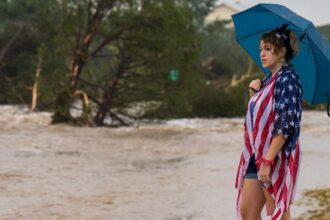Scorching temperatures are enveloping vast regions of Canada this week, as Environment Canada issues an unprecedented wave of heat warnings stretching from the Prairie provinces to the Maritime coastline. The situation has triggered urgent public health advisories and raised concerns about vulnerable populations across the nation.
The temperature spike, which meteorologists are calling one of the most extensive early summer heat events in recent years, has transformed ordinary summer warmth into potentially dangerous conditions. In Manitoba and Saskatchewan, daytime highs are forecast to reach 34°C with humidex values pushing the perceived temperature well above 40°C – conditions that can quickly lead to heat-related illnesses.
“We’re observing a concerning weather pattern where a high-pressure system has settled over central Canada, essentially creating a heat dome effect,” explains Dr. Sarah Henderson, environmental health scientist at the University of British Columbia. “These sustained high temperatures, particularly when combined with elevated humidity levels, create genuine public health risks.”
The situation in the Maritimes presents additional challenges, where coastal communities unaccustomed to prolonged heat are experiencing temperatures 8-10 degrees above seasonal norms. Halifax and surrounding areas are expected to face temperatures exceeding 30°C for at least five consecutive days, with limited overnight cooling providing little relief for residents without air conditioning.
Compounding the heat crisis in Western Canada are widespread air quality advisories resulting from wildfire smoke. British Columbia and Alberta are experiencing particularly hazardous conditions as particulate matter from multiple active fires diminishes air quality to dangerous levels. In Calgary, the Air Quality Health Index reached 7 on a 10-point scale yesterday, categorized as “high risk” for sensitive groups.
“The combination of extreme heat and poor air quality creates a particularly dangerous situation,” notes Dr. Michael Brauer, professor of public health at the University of British Columbia. “When these conditions occur simultaneously, the physiological stress on the body increases substantially, especially for those with pre-existing respiratory or cardiovascular conditions.”
Municipal authorities across affected regions have responded by extending public cooling center hours and deploying outreach teams to assist vulnerable populations. In Winnipeg, recreation centers and libraries have extended their hours to provide air-conditioned spaces for residents seeking relief. Similarly, Toronto has activated its Hot Weather Response Plan, opening cooling centers throughout the city and conducting wellness checks on isolated seniors.
Health officials are particularly concerned about rural and remote communities where access to cooling infrastructure may be limited. Indigenous communities in northern regions of affected provinces face additional challenges due to housing that often lacks adequate cooling systems and limited access to emergency services.
The current heat event coincides with troubling climate trends. According to Environment Canada data, the frequency of heat warnings has increased by approximately 22% over the past decade compared to the previous one. Climate scientists point to this pattern as consistent with global warming projections, which anticipate more frequent and intense heat events across Canada in coming decades.
“What we’re experiencing today is unfortunately likely to become increasingly common,” warns Dr. Henderson. “Communities across Canada need to develop robust heat adaptation strategies that address infrastructure, urban planning, and emergency response systems.”
As Canadians navigate this challenging heat wave, the coming days will test the resilience of both infrastructure and community support systems. With temperatures not expected to moderate until next week in most regions, the current situation serves as a stark reminder of our changing climate reality. How prepared are our communities for a future where such extreme heat events become not the exception, but the new summer norm?










